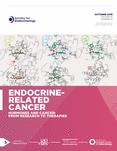Clinicopathological study of SDHB mutation-related pheochromocytoma and sympathetic paraganglioma
- Noriko Kimura1⇑,
- Kazuhiro Takekoshi2,
- Akira Horii3,
- Ryo Morimoto4,
- Tsuneo Imai5,
- Yutaka Oki6,
- Tomohito Saito7,
- Sanae Midorikawa8,
- Tadashi Arao9,
- Chiho Sugisawa9,
- Masanobu Yamada10,
- Yuichi Otuka11,
- Isao Kurihara12,
- Kokichi Sugano13,
- Minoru Nakane14,
- Atsushi Fukuuchi15,
- Takumi Kitamoto16,
- Jun Saito16,
- Tetsuo Nishikawa16 and
- Mitsuhide Naruse17
-
1Pathology Division, Department of Clinical Research, National Hospital Organization, Hakodate Hospital, 18-16 Kawahara, Hakodate, Hokkaido, 041-8512, Japan
2Division of Sports Medicine, Faculty of Medicine, University of Tsukuba, Tsukuba, Japan
3Division of Molecular Pathology, Department of Pathology, School of Medicine, Tohoku University, Sendai, Japan
4Division of Nephrology, Endocrinology and Vascular Medicine, Department of Medicine, School of Medicine, Tohoku University, Sendai, Japan
5Department of Breast and Endocrine Surgery, Aichi Medical, School of Medicine, Nagoya, Japan
6Department of Endocrinology and Metabolism, Hamamatsu Medical School, Hamamatsu, Japan
7Division of Thoracic Surgery, Department of Thoracic and Cardiovascular Surgery, Kansai Medical University, Hirakata, Japan
8Department of Diabetes, Endocrinology and Metabolism, Fukushima Medical School, Fukushima, Japan
9First Department of Internal Medicine, School of Medicine, University of Occupational and Environmental Health, Kitakyusyu, Japan
10Department of Medicine and Molecular Science, Graduate School of Medicine, Gunma University, Maebashi, Japan
11Department of Surgery, Nippon, Telegraph and Telephone East Corporation Medical Center, Tokyo, Japan
12Department of Internal Medicine, School of Medicine, Keio University, Tokyo, Japan
13Genetic Counseling Clinic, National Cancer Center, Tokyo, Japan
14Department of Oncology, Musashino Red Cross Hospital, Tokyo, Japan
15Department of Breast and Endocrine Surgery, Mitsui Memorial Hospital, Tokyo, Japan
16Department of Endocrinology and Metabolism, Japan Labour Health and Welfare Organization, Yokohama Rosai Hospital, Yokohama, Japan
17Department of Endocrinology, Metabolism and Hypertension, National Hospital Organization Kyoto Medical Center, Kyoto, Japan
- Correspondence should be addressed to N Kimura; Email: kimura-path{at}hnh.hosp.go.jp
Dear Editor
Pheochromocytoma (PCC) and paraganglioma (PGL) are genetically and phenotypically heterogeneous catecholamine-producing neoplasms. They can occur sporadically or as a part of hereditary disease. Approximately 30% of PCC/PGL are believed to be caused by germline mutations (Welander et al. 2011). Of these, succinate dehydrogenase subunit B (SDHB) gene mutation is considered a high-risk factor for malignancy. Loss of heterozygosity at the SDHB locus (1p36) was observed in all tumors with SDHB mutation, and Gimenez-Roqueplo et al. (2003) strongly suggested that SDHB is a tumor suppressor gene. Subsequently, loss of SDHB protein immunoreactivity in SDHB-mutated PCC/PGL (SDHB–PCC/PGL) was reported with 100% sensitivity and 84% specificity (van Nederveen et al. 2009). Thus, SDHB immunohistochemistry can be used to screen SDHB–PCC/PGL using paraffin-embedded pathological materials. SDHB mutation is the only established factor that indicates future metastasis. Therefore, it is important to analyze the histological characteristics of SDHB–PCC/PGL.
It is generally accepted that it is difficult to distinguish histological differences between benign and malignant PCC/PGL. The current consensus is that a long-term follow-up is required after the surgery to screen for recurrence or metastasis in all PCC/PGL patients, regardless whether hereditary or sporadic in origin. Kimura et al. (2014) proposed a histological grading system called the Grading of Adrenal PCC and PGL (GAPP) classification for predicting metastasis. GAPP is composed of six factors: histological pattern, …












